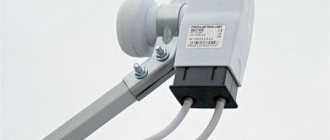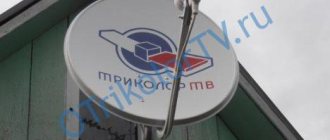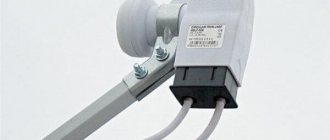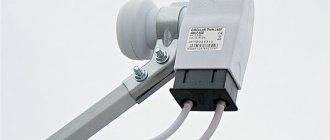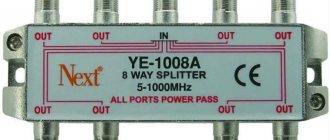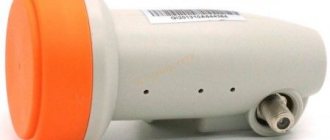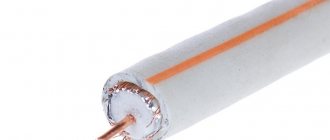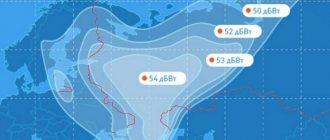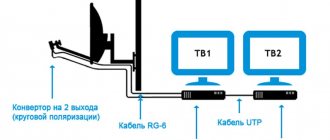There are millions of converters of different colors and configurations “hanging” on Russian satellite dishes. Increasingly, problems are arising with them, associated both with bad weather conditions and with a lack of visibility into the condition of the antenna installation. There are also problems with wave aliasing and interference from other sources, including LTE transmitters, which older types of converters cannot cope with.
How to choose a satellite converter, this is an indispensable link in the satellite television system? You can answer this question only by knowing what kind of antenna installation you plan to use, i.e. will it be reception from one or several satellites and how many tuners will be involved? Do you specifically need a converter for Tricolor or an NTV-plus converter? The type of converter always needs to be thought out in advance, because there are so many of them that you can get lost: linear, circular, universal, digital - the end of the world!
What is a converter
First of all, a satellite converter is a device that is a guide to the world of high-quality satellite TV. It is an element of a satellite antenna that amplifies received signals and converts their Ku-band frequency (10.7 - 12.75 GHz) or C-band (3.5 - 4.2 GHz) into a lower intermediate frequency 950 - 2150 MHz.
It works in the following scheme. Satellite services are provided by appropriate transponders. The video signal from the transponders hits the satellite dish umbrella, is reflected from it and hits the focal point where the converter is mounted. It irradiates the antenna and further enhances the signal. From it, amplified and converted to a lower frequency, the signal is transmitted to the input of the satellite receiver. It is in this device that real miracles happen: the converted signal comes to the TV via a coaxial cable, and you enjoy watching high-quality images.
LNB converters get their name from the abbreviation, which translated from English means “low noise block”. And in the Russian user environment you can hear the simplified name “head”.
What to do if the device does not work
A converter is a device for receiving a satellite TV signal; you can understand that it is not working based on the most important sign - the absence or decrease in the quality of the received signal.
It is very important, before blaming the converter for signal loss, to exclude all other signs:
- Bad weather. The signal may deteriorate for a short time, this is rare, but it does happen;
- Cable damage. Make sure there is no damage anywhere on the line;
- Poor contact. It can also cause signal quality deterioration. Check all connections and make sure there is no disconnection anywhere;
- Poorly installed subscriber card or insufficient funds in the account.
All these and other possible reasons for the lack of a signal should be excluded before touching the converter directly. The device is quite reliable and should not fail.
Design of satellite antenna converters
Any LNB for receiving satellite TV at home consists of:
- irradiator – volumetric metal resonator;
- receiving device (probe);
- waveguide;
- boards - electronic part.
The irradiator is needed so that the electromagnetic waves focused at one point by the dish mirror do not scatter, but are collected into a parallel beam. The feeds of direct-focus antennas differ from the feeds of offset-type dishes: in the former it has the shape of a disk with concentric circles on one side, in the latter it is in the form of a cone.
A waveguide is often a metal pipe through which electromagnetic waves collected in a parallel beam move. In cross section it can be either round, square or rectangular.
You may be interested in: Tricolor TV errors
In Ku-band heads, the feed and waveguide are made as one unit and form the converter body. In C-band heads, only the waveguide is integral with the housing; the feed is a separate part that is attached to the converter.
The LNB also includes: a waveguide-strip junction, a low-noise amplifier, a bandpass filter, a balanced mixer with a local oscillator, an intermediate frequency preamplifier, and a power supply unit. Depending on the design and purpose, each converter contains one, two or more local oscillators. The converter is usually powered from the tuner via a coaxial cable with a constant voltage of 13 or 18 volts, depending on the parameters of the currently selected time for viewing or listening to the channel.
A polarizing switch was also once an integral part of the converter, but is no longer used in practice. At the dawn of the development of satellite technology, switching between polarizations was mechanical, later magnetic switches appeared. And integrated heads have been around for many years, so few people remember this important element.
An integrated LNB for receiving signals of both vertical and horizontal polarization is known as a universal converter.
The circular satellite converter contains a depolarizer – a dielectric plate – in the waveguide. It converts a circularly polarized signal into a linearly polarized signal.
General characteristics
There is no best LNB, and there is no single parameter that would define this superiority. Converter is different from converter to converter, it cannot be characterized only by color, country of origin or the ill-fated noise indicator, which has been falsified for many years to improve sales.
A really good converter for a satellite dish is distinguished by a solid body that is resistant to weather conditions, especially the sun, because otherwise its body will crumble within a year. What is important is the repeatability of its parameters throughout the entire receiving range from bottom to top, the absence of gaps in frequencies or problems at the beginning of the reception band.
Here are the LNB characteristics that definitely deserve your attention:
| Execution | The converter housing must be made of high quality material that ensures complete sealing. It is good if the case has at least protection for the connectors to protect this area from moisture. Try to avoid products with a body in dark colors. The reason is simple: in the summer it will become excessively hot in the sun, which can lead to electronic failure or damage. |
| Noise level | The noise level introduced by an LNB into a system, better known as noise figure, is measured in decibels. Sensitive LNBs have a low noise figure and are able to receive weak satellite signals. The current standard is 0.1-0.3 dB. Noise values below 0.1 dB offered by some manufacturers border on magic rather than reflecting reality. |
| Gain | This characteristic is relevant when you have a long cable. The standard is 50-65 dB; in principle, all modern heads provide it. |
| Input | Incoming signal from a satellite dish (GHz). The most popular bands are 10.7-11.7 GHz and 11.7-12.75 GHz. Remember, the wider the range, the better. |
| Output | Output signal (MHz). The most popular ranges are 950-1950 MHz (horizontal polarization) 1100 – 2150 MHz (vertical polarization). |
| Local oscillator frequency (GHz) | For the range of 10.7-11.7 GHz it is 9.75 GHz, and for 11.7-12.75, respectively, 10.6 GHz. |
| Current consumption | Different models have different current consumption. |
| Guarantee period | It often turns out to be a decisive factor when choosing a model. For higher quality devices, manufacturers are not afraid to give it even for 5 years. |
Purpose, design and principle of operation of the converter
The converter for Tricolor TV is a compact, lightweight device. It is considered to be a single unit. But in practice, a converter with 2 outputs, 4 outputs or an advanced device with 8 outputs consists of pairs of functional blocks. It all works as follows.
- The signal coming from the satellite is amplified. A separate converter block is responsible for this. Its characteristics directly indicate the ability to generate high-quality indicators of the output signal. The noise level parameter, measured in decibels, formally indicates the distortion introduced by the device. Based on a value of 0.3 and below, you can choose a converter for Tricolor TV HD that can provide excellent picture quality.
- The second block converts the wave signal into the parameters necessary for the operation of the receiver. It also brings the broadcast to the standard adopted for conditional access televisions and other equipment capable of working with satellite signals.
Within the framework of one converter, a variety of construction schemes from the described modules can be implemented. The minimum characteristics of the final node that is needed for Tricolor is a pair of an amplifier and a wave converter with one output. The price of such a device is accessible to literally every consumer. If you need to send a signal to 2 TVs or more, you need to buy a more complex converter model.
Types of converters
A feature of satellite systems is the use of different polarizations and frequency ranges. Program transmission occurs in the C and Ku bands, and in the latter - in two subbands. Within individual varieties, there are many LNB options, differing in local oscillator frequency, input and output ranges, and the method of selecting the received polarization.
Most of those used in Europe are so-called universal LNBs or with set values of the so-called LOF (local oscillator frequency) of 9.75 / 10.60 GHz.
Older type heads with a range of 10.7-11.75 GHz and high attenuation are often called "analog" to distinguish them from "digital" ones operating in the 10.7-12.75 GHz range. This is not true. "Analog" and "digital" LNBs will work with both analog and digital satellite receivers, except that the combination of an "analog" LNB and a digital tuner will not be able to receive channels broadcast on frequencies above 11.75 GHz.
For satellite communication
On the territory of the Russian Federation, the satellite signal is distributed in the frequency spectrum C (3.5-4.2 GHz) and Ku (10.7-12.75 GHz). The C-band is used for terrestrial and satellite radio communications, because... has great advantages in operational stability.
Some satellites still broadcast in the C-band, and if they are of interest to you, your antenna will need a C-band converter. It operates in linear polarization, is slightly larger in size than its counterparts and is more suitable for direct-focus mirrors.
For satellite TV broadcasting
The use of broadcasting in the C-band, which is currently overloaded, is declining. The main broadcast occurs in the Ku-band. The transition to broadcasting in a new frequency spectrum makes reception possible with relatively compact dishes.
Regarding the satellite operators popular among Russians, for successful reception and correct operation of the equipment, choose an LNB with the correct parameters:
- converter for telecard – Ku band linear converter;
- converter for Tricolor - Ku band, circular polarization;
- head for NTV plus - Ku band, circular satellite converter.
Useful tips
Do not save money or buy converters of questionable quality from unverified sources. Do not invite unprofessional craftsmen to install the satellite system; check the quality of the purchased products and ask for quality certificates. Do not buy converters that do not meet the parameters stated in the article.
The best thing to do is simply contact the satellite television operator Tricolor TV and order a branded device based on your needs. You can also call a Tricolor technician to properly install and configure the system.
By taking these simple steps, you can provide yourself with high-quality satellite television anywhere in our beautiful and large country. Do not forget also that official equipment installed by certified specialists is covered by warranty.
Enjoy the signal quality with the Tricolor TV operator!
Number of outputs
The choice of a suitable dish head depends on the number of devices that need to receive the satellite signal.
One way out
LNB with one connector is the simplest type of converter that supports one receiver. The tuner controls the converter depending on what range and polarization it receives. The signal from such an LNB cannot be divided into two tuners with full access to the entire range. The two tuners may provide different control signals to the unit and its operation will become incorrect.
Double output
A satellite circular converter with 2 outputs is suitable for most viewers. It has two independent outputs. Essentially, these are two converters in one housing. This two-port head can support two tuners or a tuner with two signal inputs.
LNB with four outputs
More demanding users will be satisfied with a circular satellite converter with 4 outputs. This quad LNB is equipped with four independent outputs. Its housing contains four individual converters. It can support, for example, four independent tuners or two tuners with PVR function, or two conventional set-top boxes and one with PVR function. A separate antenna cable is supplied to each tuner.
LNB for eight outputs
And for dessert, for those who want to compete with the “cable guys”, a converter with eight outputs. It also has four outputs, but it is a converter designed to work with a signal splitting device called a multiswitch. Each of the outputs of the quattro block has a different range and polarization. The signal from such an LNB, supplied to a multiswitch, can be divided into several tens or even hundreds of satellite set-top boxes. Therefore, eight-port heads are used with a multiswitch in installations where it is necessary to connect more than four satellite receivers to one antenna.
Double monoblock for one output
When using it to receive from two satellites, there is no need to install two separate LNBs complete with double multifeed and a “Dysec” switch to control their operation. The signal from this LNB model is intended for one receiver.
Double monoblock with two outputs
Similar to a single-port monoblock, but with two independent outputs. Allows reception from two satellites. Can support two independent tuners or one PVR tuner.
LNB with Unicable technology
It has the same functions as a four-pin LNB, but allows you to transmit a signal to four tuners over one cable. To split the signal to different set-top boxes, a satellite splitter will be enough. Thanks to the Unicable solution, there is no need to use a multiswitch or lay separate cables from the dish and converter for each tuner.
External differences
No less important are the design features of converters, on which the scope of their operation depends. Most satellite heads only have an antenna output. But devices with two and four connectors are also available, to which you can connect the corresponding number of receivers. In practice, there are receivers with the Nth number of antenna cable sockets and are used by providers to distribute content by organizing cable television.
Polarization type
The signal coming from transponders, like any electromagnetic wave, has a parameter called polarization. Its main characteristics are the vectors of electromagnetic field strengths: electric and magnetic. The geometric location of these vectors determines the type of polarization of the coming signal.
Main types of signal polarization:
- linear (vertical and horizontal);
- circular (right and left).
The converter rotation angle is the maximum orientation of the LNB body relative to its own axis for reliable signal reception. It is not always important, but only if the angle of linear polarization does not converge. With circular polarization, it does not matter, and therefore, to receive Tricolor and NTV+, the converter does not need to be rotated.
How to check a satellite converter
The pricing policy of online stores is such that you will definitely want to purchase a converter at their attractive prices, bypassing official suppliers. But when buying such a critical element as an LNB, you must understand that you can be sure of its quality only after trying the converter in action during the initial installation.
Here are the main criteria by which you can judge the performance and quality of a product:
- after installing the head in its proper place, the satellite finder already “sees” its signal;
- the signal level in a television receiver without fine tuning is 30-40% of the quality scale;
- install the LNB in place of another (in a previously configured dish with good reception) and evaluate the difference.
